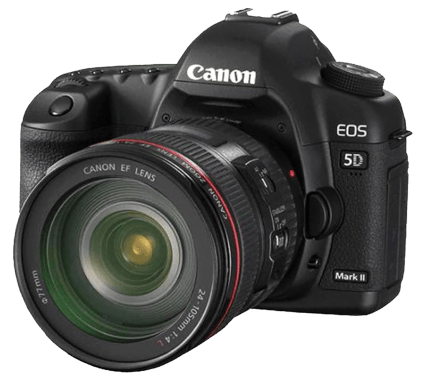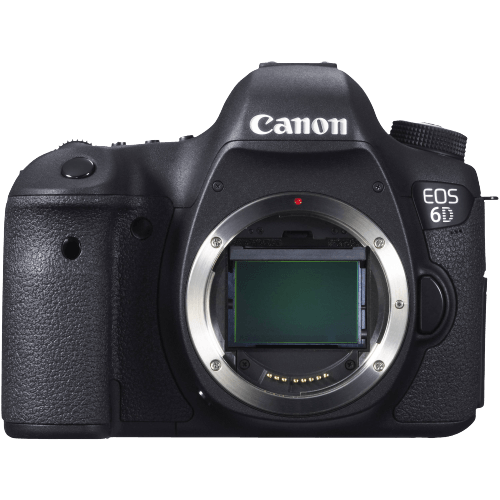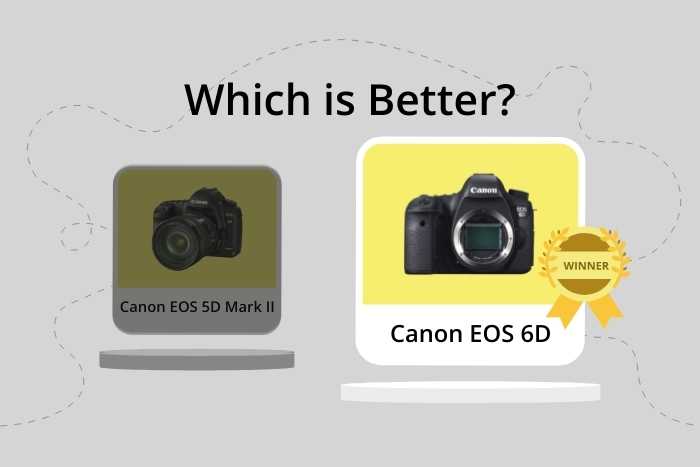Canon EOS 5D Mark II vs EOS 6D Comparison
Canon EOS 5D Mark II

Canon EOS 6D

The Canon EOS 6D narrowly beats the Canon EOS 5D Mark II with a score of 59/100 compared to 58/100. Both cameras are DSLRs, announced on September 17th, four years apart (5D Mark II in 2008 and 6D in 2012). They share similar launch prices, with the 5D Mark II at $2199 and the 6D at $2099.
The 6D has a slight advantage in size and weight, measuring 145 x 111 x 71mm and weighing 770g, while the 5D Mark II is slightly larger and heavier at 152 x 114 x 75mm and 850g. This makes the 6D more portable and convenient for photographers on the go.
On the other hand, the 5D Mark II has a sturdier build, which may be preferred by some users. The difference in scores is minimal, so both cameras offer great performance and quality. Ultimately, the choice depends on the user’s preferences and priorities.
Canon EOS 5D Mark II vs EOS 6D Overview and Optics
The Canon EOS 6D wins in the optics comparison with a score of 61/100, while the Canon EOS 5D Mark II scores 59/100. Both cameras share several specifications, including a CMOS sensor, full-frame sensor size, Canon EF lens mount, and lack of image stabilization.
The EOS 6D outperforms the 5D Mark II in a few areas. First, the 6D has a faster shooting speed of 4.5 frames per second, compared to the 5D Mark II’s 3.9 frames per second. This allows the 6D to capture fast-moving subjects more effectively. Second, the 6D features a more advanced Digic 5+ processor, which contributes to improved image quality and faster processing times. Lastly, the 6D has a higher DXOMARK score for the sensor at 82, compared to the 5D Mark II’s score of 79, indicating better overall sensor performance.
On the other hand, the 5D Mark II has a slightly higher megapixel count of 21, compared to the 6D’s 20.2. This means the 5D Mark II can capture slightly more detail in images, which may be beneficial for large prints or cropping. However, this advantage is minimal and may not be significant for most users.
In this comparison, the Canon EOS 6D emerges as the better camera in terms of optics, due to its faster shooting speed, more advanced processor, and higher sensor score. While the 5D Mark II has a small advantage in megapixel count, it is not enough to outweigh the benefits of the 6D. Therefore, the Canon EOS 6D is the recommended choice for those prioritizing optical quality.
Canon EOS 5D Mark II vs EOS 6D Video Performance
When comparing the video capabilities of the Canon EOS 5D Mark II and the Canon EOS 6D, both cameras achieve the same video score of 43 out of 100. This equality in score is due to the similarities in their video specifications.
Both the Canon EOS 5D Mark II and the Canon EOS 6D have a maximum video resolution of Full HD, with video dimensions of 1920 x 1080 pixels. Additionally, both cameras offer a maximum video frame rate of 30fps. Neither camera has built-in time-lapse functionality.
Despite having the same video score, the Canon EOS 5D Mark II has some advantages over the Canon EOS 6D. However, these advantages are not related to video capabilities, as both cameras share the same specifications in this regard. Therefore, the Canon EOS 5D Mark II does not outperform the Canon EOS 6D in terms of video capabilities.
Similarly, the Canon EOS 6D does not outperform the Canon EOS 5D Mark II in video capabilities, as they both share the same video specifications. While the Canon EOS 6D may have advantages over the Canon EOS 5D Mark II in other aspects, these advantages do not pertain to video capabilities.
Considering the equal video scores and shared specifications, it is clear that both the Canon EOS 5D Mark II and the Canon EOS 6D offer similar video capabilities. Users looking for a camera with superior video performance will not find a significant difference between these two models. Therefore, the decision between these cameras should be based on other factors such as general specifications, optics, and individual preferences.
Canon EOS 5D Mark II vs EOS 6D Features and Benefits
The Canon EOS 6D emerges as the winner in the features category with a score of 57/100, slightly higher than the Canon EOS 5D Mark II, which scores 54/100. Both cameras share several specifications, including a 3-inch screen size, the absence of a touchscreen and flip screen, and the lack of Bluetooth connectivity. Additionally, both models offer Wi-Fi capabilities.
The Canon EOS 6D outperforms the 5D Mark II in certain aspects, particularly with its higher screen resolution at 1,040,000 dots compared to 920,000 dots on the 5D Mark II. This higher resolution provides a clearer and more detailed image preview. Another distinguishing feature of the 6D is the inclusion of GPS functionality, which allows users to geotag their images with location information.
While the 5D Mark II has a slightly lower feature score, it remains a strong contender in the market. Its performance is comparable to the 6D in several areas, and it also offers Wi-Fi connectivity. However, the lack of GPS and lower screen resolution make it slightly less versatile than the 6D.
In comparing the two cameras, the Canon EOS 6D offers a few advantages over the 5D Mark II, such as a higher screen resolution and GPS functionality. Nonetheless, the Canon EOS 5D Mark II is still a solid choice for photographers who prioritize Wi-Fi capabilities and do not require GPS or higher screen resolution. Both cameras cater to different user preferences, and the choice ultimately depends on the individual’s needs and priorities.
Canon EOS 5D Mark II vs EOS 6D Storage and Battery
The Canon EOS 5D Mark II triumphs over the Canon EOS 6D in storage and battery with a score of 71/100 compared to the 6D’s 45/100. Both cameras share the same battery type, the LP-E6, and neither has USB charging capabilities.
The 5D Mark II outperforms the 6D in storage, offering two memory card slots and accepting a wider range of memory cards such as Compact Flash (Type I or II), UDMA, and Microdrive. This versatility allows for more storage options and flexibility for the user.
On the other hand, the 6D has a longer battery life, with 1090 shots compared to the 5D Mark II’s 850 shots. This advantage makes it a more suitable choice for extended shooting sessions without needing to change batteries frequently.
In terms of storage and battery, the Canon EOS 5D Mark II is the superior choice due to its greater storage capacity and flexibility. However, the Canon EOS 6D’s longer battery life may be a deciding factor for those who prioritize extended shooting sessions.
Canon EOS 5D Mark II vs EOS 6D Alternatives
If you’re still unsure which camera is best for you, get inspired with some of our other popular comparisons:

